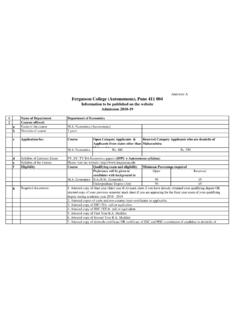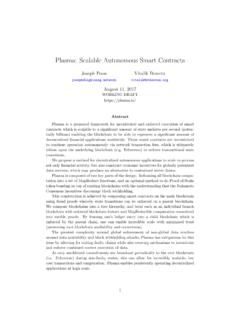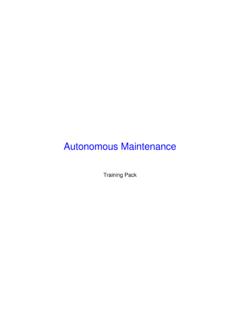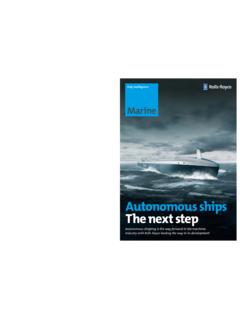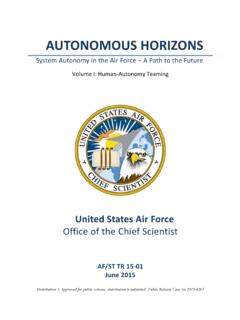Transcription of The Weaponization of Increasingly Autonomous Technologies
1 The Weaponization of Increasingly Autonomous Technologies : Artificial Intelligence a primer for CCW delegates UNIDIR RESOURCES No. 8 Acknowledgements Support from UNIDIR s core funders provides the foundation for all of the Institute s activities. UNIDIR would like to thank those who provided input to this paper, in particular Paul Scharre, as well as those who kindly reviewed it at various stages of its production. About the Project The Weaponization of Increasingly Autonomous Technologies Given that governments have a responsibility to create or affirm sound policies about which uses of autonomy in weapon systems are legitimate and that advances in relevant Technologies are also creating pressure to do so UNIDIR s work in this area is focused on what is important for States to consider when establishing policy relating to the Weaponization of Increasingly Autonomous Technologies .
2 See for Observation Papers, audio files from public events, and other materials. This is the eighth in a series of UNIDIR papers on the Weaponization of Increasingly Autonomous Technologies . UNIDIR has purposefully chosen to use the word Technologies in order to encompass the broadest relevant categorization. In this paper, this categorization includes machines (inclusive of robots and weapons) and systems of machines (such as weapon systems), as well as the knowledge practices for designing, organizing and operating them. About UNIDIR The United Nations Institute for Disarmament Research an Autonomous institute within the United Nations conducts research on disarmament and security. UNIDIR is based in Geneva, Switzerland, the centre for bilateral and multilateral disarmament and non-proliferation negotiations, and home of the Conference on Disarmament.
3 The Institute explores current issues pertaining to the variety of existing and future armaments, as well as global diplomacy and local tensions and conflicts. Working with researchers, diplomats, government officials, NGOs and other institutions since 1980, UNIDIR acts as a bridge between the research community and governments. UNIDIR s activities are funded by contributions from governments and foundations. Note The designations employed and the presentation of the material in this publication do not imply the expression of any opinion whatsoever on the part of the Secretariat of the United Nations concerning the legal status of any country, territory, city or area, or of its authorities, or concerning the delimitation of its frontiers or boundaries. The views expressed in this publication are the sole responsibility of UNIDIR.
4 They do not necessarily reflect the views or opinions of the United Nations or UNIDIR s sponsors. @UNIDIR UNIDIR 2018 i Contents Acronyms and abbreviations .. ii Introduction .. 1 What is artificial intelligence? .. 2 Machine learning .. 2 Deep learning .. 3 Computing resources .. 4 Other AI and machine learning methods .. 4 Increasing autonomy .. 5 Narrow versus general AI .. 5 Superintelligence .. 6 Practical uses of AI today .. 7 Conclusion .. 8 Appendix: Recommended resources .. 10 ii Acronyms and abbreviations AGI Artificial General Intelligence AI Artificial Intelligence ASIC Application-Specific Integrated Circuit CCW Convention of Certain Conventional Weapons GGE Group of Governmental Experts LAWS Lethal Autonomous Weapon Systems TPU Tensor Processing Units 1 Introduction Since governments began international discussions on lethal Autonomous weapon systems (LAWS) in 2014,1 the field of artificial intelligence (AI) has seen tremendous advances.
5 In just the past few years, AI systems have surpassed human abilities in benchmark games such as poker and Go and have begun to be applied to a range of real-world problems in medicine, finance, transportation, and other industries. The rapidly advancing field of AI and machine learning has significant implications for the role of autonomy in weapon systems. More intelligent machines are capable of taking on more challenging tasks in more complex environments. Some tasks that machines performed poorly at (relative to humans) in 2014, such as image recognition, machines now can reliably perform better than This complicates discussions surrounding the role of autonomy in weapons. Because of the rapid progress in AI, participants in international discussions may have different perspectives on what is possible today, to say nothing of their expectations about what may be possible in the next few years.
6 For example, only a few weeks before discussions at the Group of Governmental Experts (GGE) on LAWS in November 2017, the AI research company DeepMind released a paper on a new algorithm called AlphaGo Zero that learned to play the Chinese strategy game Go without any human training This was a significant technological achievement from the previous iteration of AlphaGo, which required initial training on 30 million moves from human AlphaGo Zero demonstrated the ability to learn a complex game from scratch given only the rules of the game. Within three days of self-play, AlphaGo Zero was able to achieve superhuman performance and beat the previous version 100 games to This development was a significant milestone in basic AI research. Although AlphaGo Zero does not have direct military applications, it suggests that current AI technology can be used to solve narrowly defined problems provided that there is a clear goal, the environment is sufficiently constrained, and interactions can be simulated so that computers can learn over time.
7 Yet even while policymakers and AI scientists are trying to understand how fundamental advances in machine learning are changing the art of the possible for AI, new advances continue. Only a few weeks after the November 2017 GGE, DeepMind released another algorithm in December 2017. This latest version, called AlphaZero, learned to play the strategy games Go, Shogi, and chess all without any human training data. Most significantly, AlphaZero is a single general purpose learning algorithm that learned to play all three games. (A separate instance of AlphaZero needed to be trained for each game.)6 This advancement demonstrates a degree of generality in the method used in AlphaZero deep reinforcement learning at least within the domain of strategy games. States face the daunting task of trying to understand the legal, policy, ethical, strategic, and other considerations of a technology that is rapidly evolving.
8 This paper is intended to be an introductory primer for non-technical audiences on the current state of AI and machine learning, designed to 1 Within the framework of the Convention on Certain Conventional Weapons (CCW). See (httpPages)/8FA3C2562A60FF81C1257CE60039 3DF6?OpenDocument. 2 Electronic Frontier Foundation, Imagenet Image Recognition, AI Progress Measurements: Vision, #Vision. 3 David Silver et al., Mastering the game of Go without human knowledge, Nature, vol. 550, pp. 354 359; DeepMind, AlphaGo Zero: Learning from scratch , no date, 4 Demis Hassabis, AlphaGo: Using machine learning to master the ancient game of Go , 27 January 2016, 5 DeepMind, AlphaGo Zero: Learning from scratch , op. cit. 6 David Silver et al., Mastering Chess and Shogi by Self-Play with a General Reinforcement Learning Algorithm , 5 December 2017, 2 support the international discussions on the Weaponization of Increasingly Autonomous Technologies .
9 Because of the swiftly changing nature of this field, this paper can only provide a snapshot in time. Many of the underlying concepts about AI and machine learning, however, are likely to remain applicable. What is artificial intelligence? Artificial intelligence is the field of study devoted to making machines Intelligence measures a system s ability to determine the best course of action to achieve its goals in a wide range of In practice, the field of AI has advanced by AI researchers picking difficult problems, such as playing chess, and then trying to build machines that can accomplish these tasks. Over time, AI researchers have moved from relatively simple games such as tic-tac-toe (noughts and crosses, beaten in 1952), to games of increasing complexity, including checkers (1994), chess (1997), the television game show Jeopardy (2011), some Atari games (2014), Go (2016), poker (2017), and the computer game Dota 2 (2017).
10 9 AI systems have also begun to perform tasks with many real-world applications, including driving vehicles, image recognition, voice recognition, language translation, and medical diagnoses. One effect of this ever-advancing field of AI is that at any point in time, only the most cutting edge machines are usually labelled intelligent . In the 1960s, chess-playing computers were at the forefront of AI research. Today, chess playing machines would not generally be called intelligent machines they are merely computer programs. Similarly, airplane autopilots, tax preparation software, automobile cruise control, smartphones, search engines, and many other software tools have some measure of intelligence. Yet because of their familiarity, they are often referred to as automation or simply computer programs.

